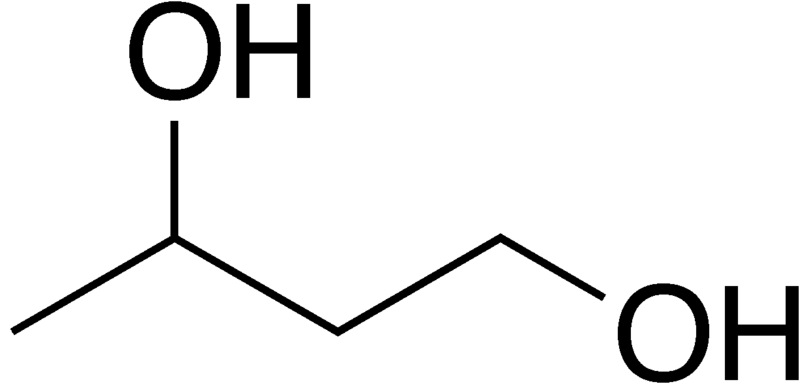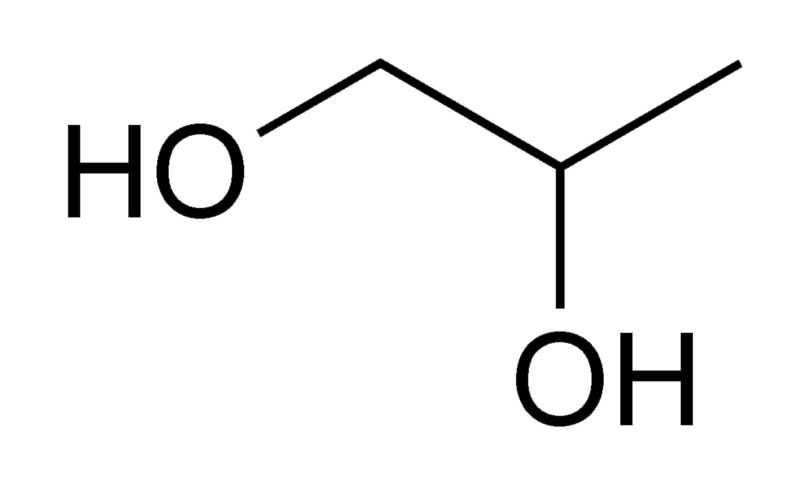What is the Difference Between Butylene Glycol and Propylene Glycol
The key difference between butylene glycol and propylene glycol is that butylene glycol has four carbon atoms and two -OH groups that are attached to two of those carbon atoms. Whereas, propylene glycol has three carbon atoms and two -OH groups that are attached to two of those carbon atoms.
Glycols are chemical compounds having two -OH groups or alcoholic groups attached to carbon atoms. Butylene glycol and propylene glycol are two such diols having a different number of carbon atoms.
CONTENTS
1. Overview and Key Difference
2. What is Butylene Glycol
3. What is Propylene Glycol
4. Butylene Glycol vs Propylene Glycol in Tabular Form
5. Summary
What is Butylene Glycol?
Butylene glycol is an organic compound having the chemical formula C4H10O2. It has four carbon atoms, and there are two -OH groups attached to two of those carbon atoms. Therefore, it is an alcohol, and since there are two -OH groups, we can call it a diol. There are four structural isomers of butylene glycol, but there are two common structural isomers of butylene glycol; 1,3-butylene glycol and 2,3-butylene glycol.
1,3-butylene glycol or 1,3-butanediol have two alcohol groups (-OH) attached to the first and third carbon atoms of a four-carbon atom chain. It occurs as a colourless, water-soluble liquid. We can prepare this substance through hydrogenation of 3-hydroxybutanal, which gives 1,3-butanediol, and that is followed by the dehydration of 1,3-butanediol to form 1,3-butylene glycol through -OH addition reactions. This substance is useful as a hypoglycaemic agent.

Figure 01: Structure of 1,3-butylene Glycol
2,3-butylene glycol or 2,3-butanediol is an organic compound having three stereoisomer forms. All these isomeric forms occur in the colourless liquid state. Two of these isomers are enantiomers, and one compound is a meso compound. We can produce this substance from hydrolysis of 2,3-epoxybutane. Moreover, this substance is useful in producing butene through deoxydehydration.
Butylene glycol is useful in manufacturing products such as shampoo, conditioner, lotion, anti-ageing creams, sheet masks, cosmetics, and sunscreen. It is also useful as a solvent helping the active ingredients that can become gritty to be dissolved.
What is Propylene Glycol?
Propylene glycol is an organic compound having the chemical formula C3H8O2. It is a viscous and colourless liquid that is nearly odourless and has a faintly sweet taste. There are two alcohol groups in propylene glycol molecules. There are three carbon atoms in a chain where two alcohol groups attached to two of these carbon atoms. Therefore, it is a diol. Moreover, this liquid is miscible with many solvents such as water, acetone, and chloroform.

Figure 02: Structure of Propylene Glycol
Propylene glycol can be produced on a large scale, primarily for the production of polymers. On an industrial scale, this substance is produced mainly using propylene oxide. This substance has uses in the food industry, pharmaceutical productions, and cosmetic production. It is useful as a solvent for both natural and synthetic substances, as a humectant, as a freezing point depressant, as a carrier or base in cosmetic production, for trapping and preserving insects, etc.
What is the Difference Between Butylene Glycol and Propylene Glycol?
Butylene glycol is an organic compound having the chemical formula C4H10O2, while Propylene glycol is an organic compound having the chemical formula C3H8O2. The key difference between butylene glycol and propylene glycol is that butylene glycol has four carbon atoms where two -OH groups are attached to two of those carbon atoms, whereas propylene glycol has three carbon atoms where two -OH groups are attached to two of those carbon atoms.
The below infographic lists the differences between butylene glycol and propylene glycol in tabular form for side by side comparison.
Summary – Glycol vs Propylene Glycol
Butylene glycol is an organic compound having the chemical formula C4H10O2, while Propylene glycol is an organic compound having the chemical formula C3H8O2. The key difference between butylene glycol and propylene glycol is that butylene glycol has four carbon atoms where two -OH groups are attached to two of those carbon atoms, whereas propylene glycol has three carbon atoms where two -OH groups are attached to two of those carbon atoms.
Reference:
1. Watson, Kathryn. “Butylene Glycol:Overview, Uses, Benefits, Side Effects, and Risks.” Healthline, Healthline Media, 20 Feb. 2019.
Image Courtesy:
1. “1,3-Butanediol” By Edgar181 – Own work (Public Domain) via Commons Wikimedia
2. “Propylene glycol chemical structure“ (CC BY-SA 3.0) via Commons Wikimedia
ncG1vNJzZmivp6x7pbXFn5yrnZ6YsqOx07CcnqZemLyue9ahmK1lmah6tbTEZpuinpaav6a6wp5km52krLKmuoybrK2xnJq7pnnGpbCcp5xirq%2BwjKmpqKipobKvsYygo7Kbn6F8